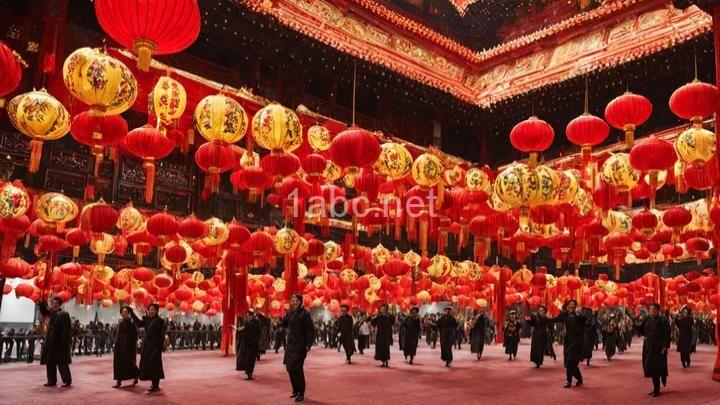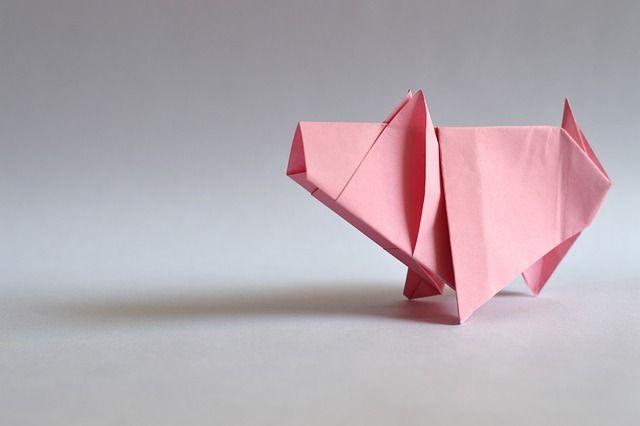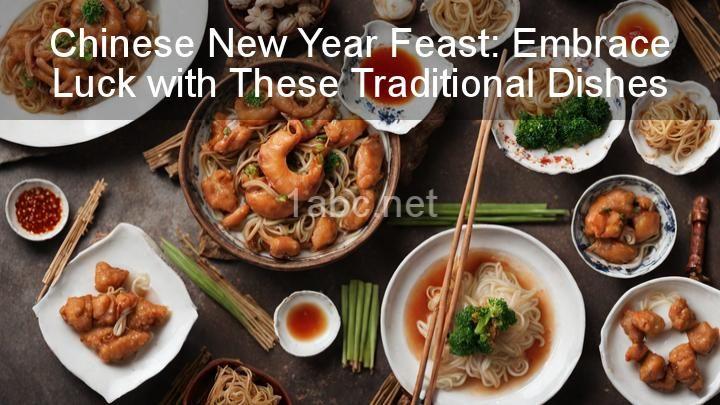Celebrating Chinese New Year Around the World: Global Festivities

Introduction:
Hello there, lovely readers! Welcome to a delightful journey through the vibrant and enchanting world of Chinese New Year celebrations. Today, we're going to dive into the rich tapestry of traditions, customs, and festivities that make Chinese New Year a truly global event. So, grab a cup of tea and get ready to be amazed by the diverse ways this cultural extravaganza is celebrated around the world.
I. Chinese New Year Traditions in China:
Let's begin our adventure in the enchanting land of China, where the roots of Chinese New Year run deep. This auspicious occasion is marked by a plethora of traditions that have been passed down through generations. One of the most cherished customs is the exchange of red envelopes, containing money, symbolizing good luck and prosperity. As the streets come alive with vibrant colors, the mesmerizing lion and dragon dances captivate the hearts of both young and old. And what would Chinese New Year be without the breathtaking fireworks that illuminate the night sky, warding off evil spirits? But beyond the external splendor, Chinese New Year holds a deeper significance. It's a time for families to come together, to honor their ancestors, and to indulge in sumptuous feasts that symbolize abundance and unity. To set the stage for this joyous occasion, homes are adorned with red lanterns and intricate paper cut-outs, spreading happiness and good fortune throughout the year.
II. Lunar New Year Celebrations in Other Asian Countries:
Our journey now takes us beyond the borders of China, to the neighboring countries that also celebrate the Lunar New Year. Vietnam, South Korea, and Singapore each have their own unique customs and traditions that bring an extra sparkle to this festive season. In Vietnam, the celebration is known as Tet, and it involves paying homage to ancestors, visiting temples, and enjoying traditional delicacies. In South Korea, Seollal is a time for families to gather and perform ancestral rites, while children bow to their elders and receive blessings in return. And in Singapore, the vibrant Chingay Parade and River Hongbao Festival capture the spirit of Chinese New Year, showcasing the multicultural tapestry of the nation.
III. Chinese New Year Across North America:
Now, let's hop across the Pacific Ocean and explore how Chinese communities in North America celebrate this joyous occasion. From bustling cities like New York and San Francisco to vibrant communities in Vancouver and Toronto, Chinese New Year brings an explosion of color, sound, and flavor. Parades wind through the streets, filling the air with the rhythmic beats of drums and the graceful movements of lion and dragon dancers. Street fairs and cultural performances offer a glimpse into the rich heritage of Chinese traditions. And of course, food festivals tantalize the taste buds with an array of delicious dishes, from dumplings to tangyuan. These celebrations not only bring joy to the Chinese diaspora but also provide an opportunity for locals to immerse themselves in the vibrant tapestry of cultures that make up these diverse cities.
IV. European Cities Embracing Chinese New Year:
Our journey now takes us to the charming cities of Europe, where an increasing number of communities are embracing the beauty of Chinese New Year celebrations. London, Paris, and Berlin have all started incorporating this cultural extravaganza into their annual calendars. In London, the streets come alive with dragon boat races and dazzling exhibitions that showcase both traditional Chinese art forms and contemporary interpretations. Paris, known as the "City of Love," embraces the spirit of Chinese New Year with open arms, hosting vibrant performances and art shows that bridge the gap between cultures. And in Berlin, the Chinese Lantern Festival illuminates the city with a kaleidoscope of colors, spreading warmth and joy during the cold winter months. These celebrations serve as a reminder of the importance of cross-cultural exchange and understanding in our increasingly interconnected world.
V. Unique Ways of Celebrating in Australia:
Lastly, let's journey to the "Land Down Under" where Chinese New Year celebrations take on a unique and captivating twist. In cities like Sydney and Melbourne, iconic landmarks like the Sydney Opera House and the Melbourne Town Hall are bathed in a sea of red lights, symbolizing prosperity and good fortune. Multicultural festivals abound, showcasing not only traditional Chinese festivities but also various aspects of Asian culture. From mesmerizing performances by lion dancers to mouthwatering street food, these celebrations offer a delightful fusion of tradition and innovation, bringing people from all walks of life together to celebrate diversity and unity.
Conclusion:
As our whirlwind tour of Chinese New Year celebrations around the world draws to a close, we hope you've been inspired to explore and participate in these extraordinary festivities. From the bustling streets of China to the charming cities of Europe and the vibrant communities of North America and Australia, Chinese New Year serves as a beautiful reminder of the power of culture to bring people together. So, whether you're exchanging red envelopes with loved ones, savoring mouthwatering delicacies, or marveling at mesmerizing performances, we wish you a joyous and prosperous Chinese New Year, wherever you may be. Happy travels and happy celebrations!
FREQUENTLY ASKED QUESTIONS
What is the significance of Chinese New Year?
Chinese New Year, also known as the Spring Festival, holds significant cultural and historical importance in Chinese communities around the world. It marks the beginning of the traditional Chinese lunar calendar and is celebrated with great enthusiasm and joy.The significance of Chinese New Year lies in its rich cultural traditions and customs. It is a time when families gather together to honor ancestors, pay respect to deities, and strengthen bonds with loved ones. The festivities typically last for 15 days, filled with various activities and rituals.
One of the main aspects of Chinese New Year is the reunion dinner, where family members come together to share a lavish meal and exchange good wishes for the coming year. This meal symbolizes unity and harmony within the family.
Another important tradition is the giving of red envelopes, known as "hongbao," which contain money. These red envelopes are given to children and unmarried adults as a symbol of good luck, prosperity, and blessings for the new year.
Fireworks and firecrackers play a significant role in Chinese New Year celebrations. The loud noises are believed to scare away evil spirits and bring good fortune for the year ahead.
The color red is also highly symbolic during Chinese New Year. It represents happiness, good luck, and warding off negative energy. Red decorations adorn homes and streets, creating a festive and vibrant atmosphere.
The lion and dragon dances are captivating performances that are believed to bring good luck and prosperity. These dances involve intricate movements and are accompanied by the rhythmic beats of drums and cymbals.
In addition to the cultural significance, Chinese New Year also holds economic importance. It is a time when businesses close for a period of time, allowing employees to return home and celebrate with their families. This mass migration of people, known as the "Spring Festival travel rush," is considered the largest annual human migration.
Overall, Chinese New Year is a time for reflection, gratitude, and renewal. It embodies the values of family, tradition, and community, while also bringing hope and excitement for a prosperous year ahead.
How is Chinese New Year celebrated around the world?
Chinese New Year, also known as the Spring Festival, is celebrated with great joy and enthusiasm around the world. The customs and traditions may vary from country to country, but the essence of the celebration remains the same - to welcome the lunar new year and bid farewell to the old.In countries with a significant Chinese population, such as Malaysia, Singapore, and Thailand, Chinese New Year is a public holiday. Streets are adorned with vibrant red lanterns, and traditional lion and dragon dances take place to ward off evil spirits and bring good luck. Families gather for reunion dinners, where they enjoy sumptuous feasts and exchange red envelopes filled with money, symbolizing good fortune.
In Western countries like the United States, Canada, and Australia, Chinese communities come together to celebrate Chinese New Year. Festivities often include parades featuring colorful floats, traditional music, and dance performances. People wear traditional Chinese clothing, such as qipao and cheongsam, and participate in activities like lantern making and calligraphy.
Even in non-Chinese majority countries, Chinese New Year is embraced and celebrated. In London, for example, the vibrant Chinatown becomes the center of festivities, attracting visitors from all over the world. The streets are filled with decorative lights, and various cultural events, such as martial arts demonstrations and traditional music performances, take place.
No matter where it is celebrated, Chinese New Year is a time for family and community. It is a time to honor ancestors, express gratitude, and set intentions for the upcoming year. The festivities create a sense of unity and joy, as people come together to celebrate the rich cultural heritage of the Chinese community.
So, whether you're in China, Malaysia, the United States, or anywhere else in the world, Chinese New Year is a time of celebration, tradition, and hope for a prosperous year ahead.
Are there any specific customs or traditions associated with Chinese New Year?
Yes, Chinese New Year is rich with customs and traditions that have been celebrated for centuries. Here are a few notable ones:
-
Reunion Dinner: Families gather on the eve of Chinese New Year for a special meal called the Reunion Dinner. It is a time for loved ones to come together and share a feast, symbolizing unity and togetherness.
-
Red Packets: These are small envelopes filled with money that are given as gifts during Chinese New Year. Red is considered an auspicious color and the act of giving red packets is seen as a way to bring good luck and blessings to the recipients.
-
Lion and Dragon Dances: Colorful lion and dragon dances are performed during Chinese New Year parades and festivities. The loud drums and cymbals are believed to ward off evil spirits and bring good fortune for the coming year.
-
Firecrackers: Lighting firecrackers and fireworks is a popular tradition during Chinese New Year. The loud noises are believed to scare away evil spirits and bring good luck.
-
Spring Cleaning: Before the start of Chinese New Year, people engage in a thorough cleaning of their homes. This is done to sweep away any bad luck from the previous year and make way for good fortune in the coming year.
-
New Year Scrolls: People often hang scrolls with auspicious wishes and blessings on their doorways during Chinese New Year. These scrolls are beautifully decorated and are believed to bring good luck to the household.
These are just a few examples of the customs and traditions associated with Chinese New Year. Each region and family may have their own unique practices, but the underlying theme of celebrating new beginnings and fostering good fortune remains the same.
What are some traditional foods eaten during Chinese New Year?
During Chinese New Year, there are several traditional foods that are commonly enjoyed. One popular dish is "jiaozi," which are dumplings filled with various ingredients such as meat, vegetables, or seafood. These dumplings are said to resemble ancient Chinese currency and are believed to bring wealth and prosperity in the coming year.Another traditional food is "nian gao," which is a sticky rice cake. The name "nian gao" sounds similar to the Mandarin word for "higher year," symbolizing a wish for a better and more prosperous year ahead. This sweet and chewy cake is often steamed or fried and can be served plain or with fillings like red bean paste.
"Yusheng" or "lo hei" is a popular dish during Chinese New Year in Singapore and Malaysia. It is a colorful salad made with various ingredients such as raw fish, shredded vegetables, and crunchy toppings like peanuts and sesame seeds. The dish is typically tossed high in the air while shouting auspicious phrases, symbolizing a wish for good luck and prosperity.
Additionally, "tangyuan" is a dessert commonly enjoyed during the Lantern Festival, which marks the end of the Chinese New Year celebrations. These glutinous rice balls are usually filled with sweet fillings like sesame paste, red bean paste, or peanuts and are served in a sweet soup.
These traditional foods not only have symbolic meanings but also bring families and friends together to celebrate the joyous occasion of Chinese New Year.


